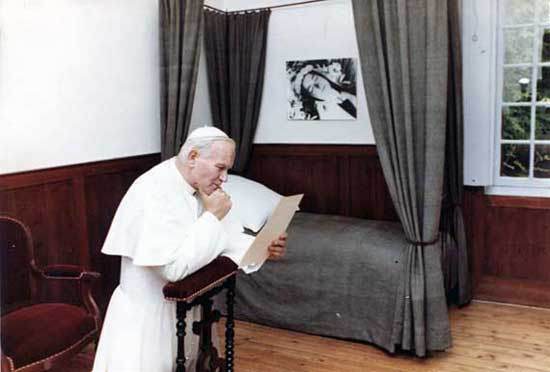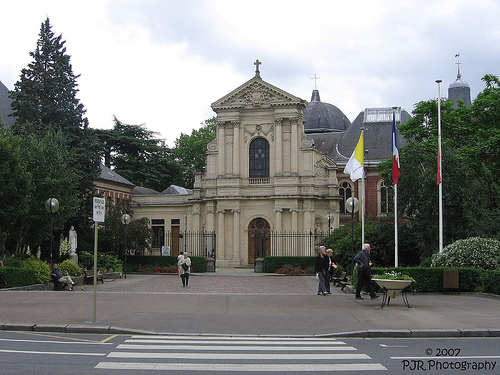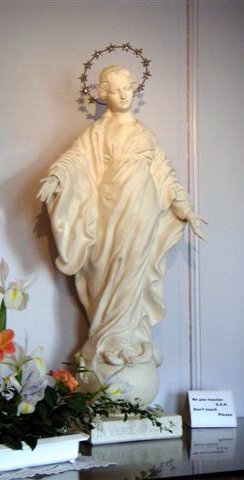Saint Therese of the Child Jesus
of the Holy Face
Our new saints!
 St. John XXIII and St. John Paul II
St. John XXIII and St. John Paul II
St. John XXIII and St. John Paul II: the friends of St. Therese of Lisieux
As the world looks forward to the canonization tomorrow of Blessed John XXIII and Blessed John Paul II, we remember that both Popes held St. Therese as a dear friend. Many Popes have loved St. Therese and trusted confidently in her intercession for them.

Pope John XXIII (public domain photo, released by the Vatican)
In his lifetime Angelo Roncallli, Pope John XXIII, made five pilgrimages to Lisieux, most while he was Papal Nuncio in Paris, but also as Apostolic Delegate in Bulgaria. He said:
"I shall never cease blessing and exalting the little and great saint who has always been, and always will be, the lucky star of my mission in France. It was at the altar in the chapel dedicated to her in Ankara, in the heart of Turkey, that I bade farewell to the Orient, where I had spent twenty years of apostolic ministry. Every day, I look at her marble statue in my private chapel in the nunciature; better still, I turn to her in prayer and confide to her all my problems and difficulties in the ministry of reconciliation and peace which is my mission in the service of the Holy Church and of France also."
Pope John Paul II showed his love for St. Therese from the very start of his pontificate. On June 2, 1980 he made a Papal visit to Lisieux.

(© Yves Jeanmougin, http://www.yvesjeanmougin.com)
The photographer, M. Yves Jeanmougin, graciously created for this Web site a gallery of his enchanting photographs of Pope John Paul II's visit to Lisieux.
 June 2, 1980: Pope John Paul II praying in the infirmary where St. Therese died.
June 2, 1980: Pope John Paul II praying in the infirmary where St. Therese died.
Years later, on March 26, 1994, Pope John Paul II declared Therese's mother and father, Blessed Louis and Zelie Martin, "venerable" (an important step on the road to sainthood). Thet were declared blessed by Pope Benedict XVI on October 19, 2008.
On August 24, 1997, in his Angelus message at the close of World Youth Day in France, Pope John Paul II announced that he would name St. Therese of Lisieux a Doctor of the Church on Mission Sunday, October 19. Three days later, at his general audience on August 27, 1997, he described Therese as the "authoritative teacher" of the "overwhelming message of God's love."
At the ceremony on October 19, 1997, the Pope's Apostolic Letter proclaiming St. Therese a Doctor of the Church, was proclaimed; it was titled "Divini Amoris Scientia" (the Science of Divine Love). He said that Therese's teaching
excels for the depth and wise synthesis it achieved. Her doctrine is at once a confession of the Church's faith, an experience of the Christian mystery and a way to holiness. Thérèse offers a mature synthesis of Christian spirituality: she combines theology and the spiritual life; she expresses herself with strength and authority, with a great ability to persuade and communicate, as is shown by the reception and dissemination of her message among the People of God.
In this letter the Pope also stressed the importance of Therese as a woman, a contemplative, and a young person. In his homily at the Doctoral Mass, Pope John Paul II stated:
Therese of Lisieux did not only grasp and describe the profound truth of Love as the center and heart of the Church, but in her short life she lived it intensely. It is precisely this convergence of doctrine and concrete experience, of truth and life, of teaching and practice, which shines with particular brightness in this saint, and which makes her an attractive model especially for young people and for those who are seeking true meaning for their life. Before the emptiness of so many words, Therese offers another solution, the one Word of salvation which, understood and lived in silence, becomes a source of renewed life. She counters a rational culture, so often overcome by practical materialism, with the disarming simplicity of the "little way" which, by returning to the essentials, leads to the secret of all life: the divine Love that surrounds and penetrates every human venture. In a time like ours, so frequently marked by an ephemeral and hedonistic culture, this new Doctor of the Church proves to be remarkably effective in enlightening the mind and heart of those who hunger and thirst for truth and love. An eminent model and guide for Christians today.
The next day, in his speech to the pilgrims gathered in Rome for the doctoral Mass, Pope John Paul said:
For our time Thérèse is a powerful and accessible witness of an experience of faith in God, the faithful and merciful God, who is just by his very Love. She lived deeply her membership in the Church, the Body of Christ. I think that young people really find in her an inspiration to guide them in the faith and in ecclesial life, at a time when their way can be crossed by trials and doubts. Thérèse experienced all kinds of trials, but it was granted to her to remain faithful and trusting; she bears witness to that fact. She supports her brothers and sisters on all the paths of the world.
We rejoice to see the Popes who understood the mission of St. Therese of Lisieux so well join her as canonized saints.
"Why Make Saints?" - a video by Fr. James Martin, S.J.
In this short video Father James Martin, S.J. responds to recent critiques of the canonization process. Father Martin's favorite saint, of course, is Therese of Lisieux!
Most of the substance of this excellent video also appears in Father Martin's article "Do we still need saints?" in the Washington Post. Enjoy!
A three-minute video of the entrance to the Carmelite monastery at Lisieux

Photo credit: Paul Ryan
View this three-minute video of the entrance to the Lisieux Carmel: see the enclosure door in the sacristy through which Therese entered on April 9, 1888, the cloister courtyard, and the statue of the Child Jesus she was in charge of decorating. Thanks to the Carmel of Lisieux for sharing this video.
"More Mother than Queen: Mary in the Life and Spirituality of St. Therese of Lisieux and Her Family"
An Encounter with St. Thérèse of Lisieux
and her parents, Blessed Louis and Zélie Martin
Pray in the presence of their relics
at the Carmelite Monastery in Philadelphia
on Sunday, May 4, 2014 from 10:00 a.m. to 4:00 p.m.

“More Mother Than Queen:
The Role of Mary in the Life and Spirituality of St. Thérèse of Lisieux and the Martin Family”
- a conference by Maureen O’Riordan at 1:00 p.m.
Benediction of the Blessed Sacrament at 3:30 p.m.
Carmelite Monastery
1400 66th Avenue
(66th Avenue and Broad Street)
Philadelphia, Pa.
Free parking
n the monastery's lot on 66th Avenue
Chapel is handicapped-accessible
Bookstore Open 10:00 a.m. to 3:30 p.m.
Spiritual books, children's books, DVDs, and religious articles.
Cash and checks only, please.
A replica of the statue of the
Blessed Virgin before which Therese
and her sisters were praying when Therese
was cured of a serious illness at age ten.
Photo credit: Susan Ehlert
Download the flyer
In the month of Mary, my conference will look at her role in the lives of the Martin family and especially of St. Therese. In this conference, written for the national conference of the Secular Order of Discalced Carmelites in Wakefield, Massachusetts in August 2012, I explore four themes:
- Mary as Therese’s mother; the childlike, filial love for her that Therese never lost.
- Mary who suffers with us and with Jesus: the Mother of Sorrows
- Mary as the model of the way of confidence and love
- Mary who gives Jesus to us and unites us to him
This presentation on May 4 will be the premiere of this conference in the mid-Atlanic region. I hope that many secular Carmelites, lay Carmelites, and others especially interested in Mary, the mother of Jesus in the life of the Martin family will take advantage of this opportunity to examine her influence on this holy family and the source of grace she is to us.